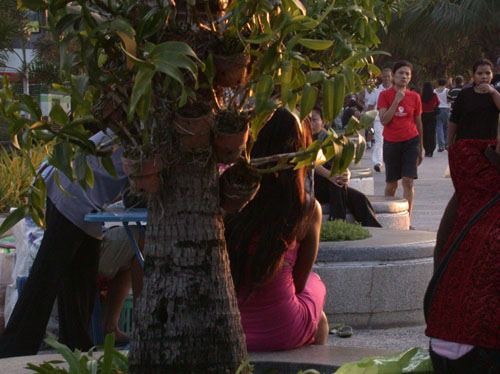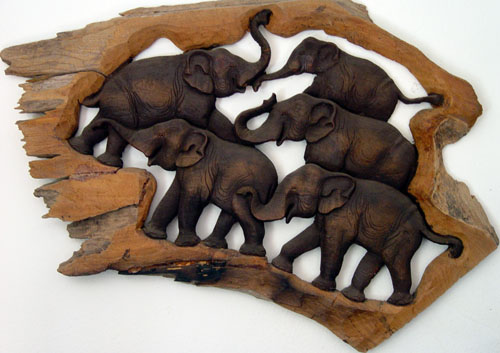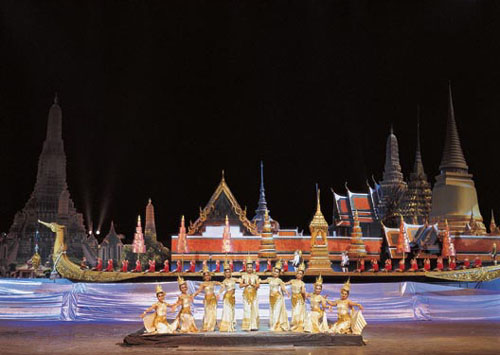|
The arts of Asia abide – as expansive and merchandised as in any other part of the world. What supports this is the lingering vibrancy of colonialism. There are only small traces of the political colonial powers of the last century. Today, it is the rampage of the corporate colonial powers that divides and sub-divides the Asian world–and they don't need flags with marching bands. In fact, colonialism never left, it just changed its clothes. In fact, colonial conquistadores and robber barons have always been with us and... with Asia. Most of the newly independent nations in that large region of this small planet were at one time or another independent empires, imperialists who conquered and colonized and ruled, some in a fashion that would make the French and British look benevolent. Just roam into the history of the Khmer, or Siamese, or Burmese empires: hundreds of years of "king and country and your daughter, if you please." And, of course, there was the Chinese empire, the largest and greatest colonial power in history.
Equally striking – the numerically tiny upper classes frantically trying to keep the fattening middle classes off their backs, trying to keep entré to a trickle through the cracks in the garden wall. And both of these upper echelons are desperately trying to swat away the numerically larger lower classes from swarming into their privileged lives like mosquitoes swooshing over a downed net. It is, in this day of instant communication, an instant portrait of three primordial elements of human life: blood, oxygen, and hypocrisy.
Asia, especially the economic tigerville of SE Asia, is having a disruptive time handling the explosion of communications and goods, plus here-today-gone-tomorrow cultural influences that Westerners pour through their borders. Most are having a hellish time envisioning what they are "supposed" to look like and reconciling the ancient unquestioned difference between men and women (the only difference between human beings said Strindberg, one lonely night in Uppsala!). Arrogantly and incredibly, it includes the Japanese, as well.
But not in Thailand, a centrally positioned cultural crossroads. The Thais have a cultural ether that absorbs. It is their historical legacy.
In the hey-day of European haute-cuisine-d'imperiale and American manifest-destiny, Thailand managed a marvelous juggling act and emerged as a buffer between their colonized neighbors. Though rudely slapped around by the French (and haven't we all!), the Thais really didn't suffer the pain of occupation until the Japanese madness drowned the entire region during World War II. After that nightmare, they conservatively and cleverly allied themselves with the West, especially with the U.S. It was during the next madness, the Vietnam War, that today's colonial invasion began. The American military, operating out of Thailand, decided they had found a rest&relaxation garden of eden. And they were right.
Affectionately known as the Land of Smiles, the kingdom of Thailand offered a gentle tropical climate, a gentle, poor population with a fairy-tale exchange rate, and a gentle, affectionate, smiling-laughing, embracing flowerbed of women. The American boys, half-literate, half-mary-janed, and totally disoriented, thought they had stumbled into heaven before any bullet or blade took them there. And they were right.

So began the invasion of this dreamland of mists and smiles; so today, the tourist industry is Thailand's biggest business. Nearly 12 million come to visit a population of 65 million, every year. The commodities are – defiantly low prices, grand food, magnificent art and architecture, low prices, and low stress. In the midst of all this, facing the same doubts and troubles of the entire region, Thailand thrives. It aggressively strides to escape the third-world swamp into the garden of the first-world. It paid off its tribute to the World Bank and, recently, opened a world-class, nearly $4 billion dollar airport that rivals any airport in the world and surpasses many. The Thai infrastructure is impressive – a modern education system, modern transportation, the internet, cell phones, cable television, and a surprisingly robust health care system, along with a high tech industry, agribusiness, a home for corporate colonies looking for skilled, relatively inexpensive labor, industrious workers, and a friendly bureaucracy.
Media is abundant in Thailand, most of it, news and programming, imported because much of the local stuff is stuck in the age of the "Brady Bunch." Literature is prevalent, though Thais, like Americans and the French, are reading less. The visual arts, painting, sculpture, ceramics, weaving, are embedded in everyday life – part of a long tradition.

The film industry is lunging out of adolescence supported and spurred by the perceived wizardry of Francis Coppola and Oliver Stone. But it is the performing arts experience that is truly special... Thai music, Thai dance, and Thai theatre... different from anything else in Asia, as profound as the Japanese and Chinese, and as beautiful.
Bangkok is the hub – a sprawling, polluted metropolis of 10 million that overwhelms its 200 years of treasures, not unlike New York, Tokyo, London and Paris. As a crossroads, this charming city offers dance, pop and classical music concerts, opera, an array of world cinema, an array of the array of world arts. On a smaller scale, the smaller Thai cities reflect the hub.
Look into the mirror. The mosaic is dazzling. To grasp the range and impact, you need to step though the looking glass into a few pieces of the array, such as these:
In the party city of Pattaya, there is a palace of a theatre, with a huge faux-marble lobby that mimics a grand opera house. It boasts a large, comfortable 1000-seat theatre with an enormous stage equipped with the latest audio-visual systems. It's called, Tiffany's.
It produces its own performance – a revue, a vaudeville, a classic cabaret theatre-piece, with dance, music, synchronized song, complex staging and as many as 100 performers. The sets are as lavish and well designed as you would see anywhere. The costumes are expensive, and to coin a phrase, "spectacular." But beyond this obvious entertainment lure is the main attraction: the cross-dressing actors, mainly men with a few women. They are part of a deep tradition in Thai performing arts with little of the smirking insinuations that Americans heap on their cross-dressing performers. The colloquial word is "Ladyboy." In most quarters they are revered and they are renowned in Asia for their beauty.

Every night, two performances, packed houses, 2000 people, tourists and locals, stream into this theatre as they have done for over 30 years. It is considered family-theatre and families are abundant in the audience on any given night.
South of Pattaya, in the province of Chonburi, near the beach, behind a cluster of aging apartment houses... a theatre. Plain, portable seating, clean, a brown version of a "black box." An amazing audience of about 150, not home watching one of the 25 cable channels. A number of them from that tiny upper class, a number from the middle level, the rest seemingly ordinary people who could afford the 100 baht ticket (about $2.50US). 12 actors on a very small stage, with simple but effective lighting, painted cloth backdrops, two musicians (flute and drum) and a tech person. It was a new play by Satang, a local playwright. The title – "Here Is The Mirror". The actors were in the most outrageous, outlandish costumes and makeup that one could imagine. It opened in a flurry of slapstick, over-the-top comedy that fit the over-the-top costumes-makeup perfectly. Then the drama began, and that did not fit. The incongruity was stunning. For nearly two hours (with a slight intermission) the actors wove a story of love and pain, of coming together and breaking apart, of pairs of people interchanging their lives, finding themselves, losing themselves, finding themselves again.
Fortunately, I sat in the back next to two people who spoke some English. So every time I looked their way, they whispered a few words to clue me. It was hardly necessary. This work could have been performed in mime... it had that much clarity. The actors had that much clarity in their movement and voices, in the truth they portrayed, and their belief in the truth they transmitted to the audience. My newfound friends were rather amazed at how much of the story and the language I was able to grasp. It wasn't me... it was they, the actors. This was theatre at its essential center... actors and their audience (a wonderfully mixed audience!) without polemics and politics and without the packaging of production and effects and thrill-juice. I gratefully experienced this once more in Bangkok and again in Chiang Mai, way up North. It was life as art and art as life... through a looking glass, in Thailand, in Asia.
|

